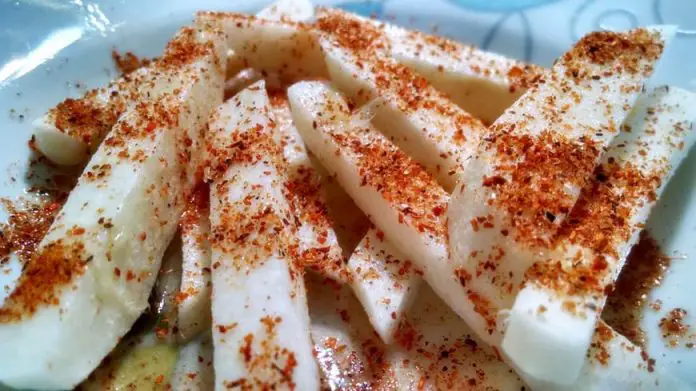Can dogs eat jicama?
There are many foods (especially human foods) out there are not safe for your dog to eat. However, fortunately for us, jicama is not one of those hazardous foods. No matter how you look at it, this tasty vegetable is definitely safe for your puppy to consume and can be enjoyed from time to time without any worries or problems whatsoever. Many people even consider jicama as a super food, due to it being extremely healthy by having an abundance of nutrients while also being pretty low in calories.
I don’t really have much experience in eating or handling jicama as it wasn’t a particular staple food within my diet or my dog’s one. Despite this fact, after learning about the numerous benefits, nutritional contents, and most especially delicious taste of this vegetable, I’ve given a sincere effort into making jicama not only a part of my routine diet but also a part of my dog’s food intake as well! I would highly recommend that you do so as well!
This vegetable is praised with high regards and considered to be extremely beneficial to your dog’s health as well as being non-toxic. All these arguments should at least gain your interest in changing your canine companion’s diet in order to add a little more variety in the foods that he eats. Before we talk further about the inherent benefits of jicama, we should first elaborate on what exactly a jicama is in order for those who don’t know of this delicious fruit to be made aware of its existence.
What is a Jicama?
Jicama isn’t exactly a popular vegetable in the United States, and I believe this is due to the fact that it’s an edible root vegetable that is native to Mexico. Alternative names for jicama are the Mexican turnip, Mexican potato, and sometimes yam bean. Jicama also belongs to the bean family, hence the name yam bean being given to it. In terms of taste, it is said to have a mild flavor while also having a delectable and satisfying crunch to it. You can either eat jicama raw or cooked, with the vegetable having a sweet and starchy flavor that is very much enjoyable.
It is also important to note that the leaves, skin, and seeds of this vegetable are toxic to your dogs. A toxin called rotenone can be found in these parts of the plant and can definitely be detrimental to their health as it would cause serious health problems, and in the most extreme cases, even death. Other than the toxic and inedible parts of the plant, jicama is a wonderful choice of food for your dog as it is really healthy!
The Benefits of Feeding Jicama to Your Dog
Now that you’ve been made well aware of what exactly a jicama is, I think it is time to introduce the specific health benefits that your dog can get from eating this amazing vegetable! I’ll be highlighting the key nutrients that really make jicama a worthy food in your puppy’s diet.
1. It is high in dietary fiber. Fiber aids in the digestion of other substances within the body, as well as affecting the general bulkiness of stool. Though fiber is not a highly essential nutrient for them, the additional fiber in your dog’s diet obtained through the consumption of jicama can help improve their colon health as well as prevent constipation, diarrhea, and other conditions for the bowels. The occasional treat of jicama would definitely help to regulate the natural flow of your dog’s digestive tract! Extra fiber in your dog’s diet would improve his overall metabolism.
2. It contains vitamin A, vitamin C, iron, and potassium. The all-important vitamin A helps keep the skin, bones, and teeth of your dog healthy. Vitamin A improves the general well-being of his fur and coat and is a great vitamin for small puppies due to the fact that it helps support growth and health. Jicama can act as a way to slowly introduce this much-needed vitamin in your puppy’s diet.The all-important vitamin C helps prevent skin diseases in them, and improves the immune system of them by upgrading their white blood cells to fight against nasty bacteria and viruses that could their health! Jicama can serve as a great way to sneak in the vitamin in your dog’s diet while also upgrading his meal into something more delicious!
3. It is low in calories! I personally find this as extremely helpful. The fact that jicama does not contain a substantial amount of calories in every serving means that it will protect him against any unneeded weight gain! Controlling your dog’s weight is essential in order to prevent him from any health issues or problems such as diabetes and pancreatitis.
Though it can be said that jicama is an extremely healthy food for your dog, it isn’t exactly an essential part of his diet. At the end of the day, jicama is still considered to be a human food, and as with all human foods, should be given to them with care. It can be argued that jicama is a staple ingredient in some dog foods, but it isn’t present in all of them! The much-needed nutrients that your dog needs every day can easily be found in his kibble or regular dog food. Although I do admit, an occasional treat of jicama wouldn’t hurt from time to time!
Ways to Feed Jicama to Your Dog
After reading and learning all those health benefits, any loving dog owner would think that jicama would make a great as a great treat, and they would be right! There are actually a number of ways to feed jicama to them. Our canine companions aren’t really considered as picky eaters, which is why you’re more or less free to choose how to feed jicama to your dog!
However, the most important thing you should remember when feeding jicama to your puppy is to always remove the skin. The skin, together with the leaves and vines are toxic to your dog and shouldn’t even be considered as a possible food for your pet to eat.
You can either feed your dog cooked or raw jicama. If you do give raw jicama to your dog, make sure to keep a close eye on him as the high fiber content of the vegetable might not go so well with your pup, especially if he’s not exactly used to eating food with high amounts of fiber in the first place.
I would personally recommend that if it is your puppy’s first time trying jicama, or if he has some sort of low tolerance to fiber enriched foods, that you first cook jicama before serving it to your dog. That way it would be a lot easier for your dog to consume and enjoy it. They are mainly carnivores if you look at it from the natural perspective, meaning they specialize more in eating raw meat than eating greens or vegetables.
An important thing to note is that jicama should be served without any seasoning! If you decide to feed it to them, it should be as plain as possible. Most seasonings like salt, pepper, and sugar are pretty detrimental to your dog’s health so it would be best to exclude them if you’re planning on cooking up a dish for your faithful puppy. In addition to that, if you plan on cooking jicama together with a bunch of other vegetables, be sure to make it a point to know if each and every other vegetable is also safe for your dog’s consumption.
Lastly, I’ve learned that it is also possible to put jicama in your blender and puree it, turning it into a liquid to be mixed with your dog’s usual food. I personally think this is the best way to feed jicama to your dog as its presence is only subtle and doesn’t actually interfere with your dog’s usual diet. It’ll also serve as a great way to sneakily incorporate the much-needed vitamins and minerals into your dog’s diet as it is simply mixed with his usual food.
Conclusion
No matter how you look at it, it is always up to the dog owner to carefully supervise and judge whether or not a certain food is safe for a puppy to eat. Thankfully though, jicama is a tasty vegetable that is also rich in nutrients and minerals that’ll surely aid in a dog’s health! The most important thing to remember is to always remove the skin, leaves, and seed when feeding jicama to your pet, as these aren’t edible. This tasty Mexican yam will surely pique your dog’s interest! If you find your dog enjoying his first meal with the vegetable, I can assure you that jicama (pronounced HEE-kah-ma) for more!






















